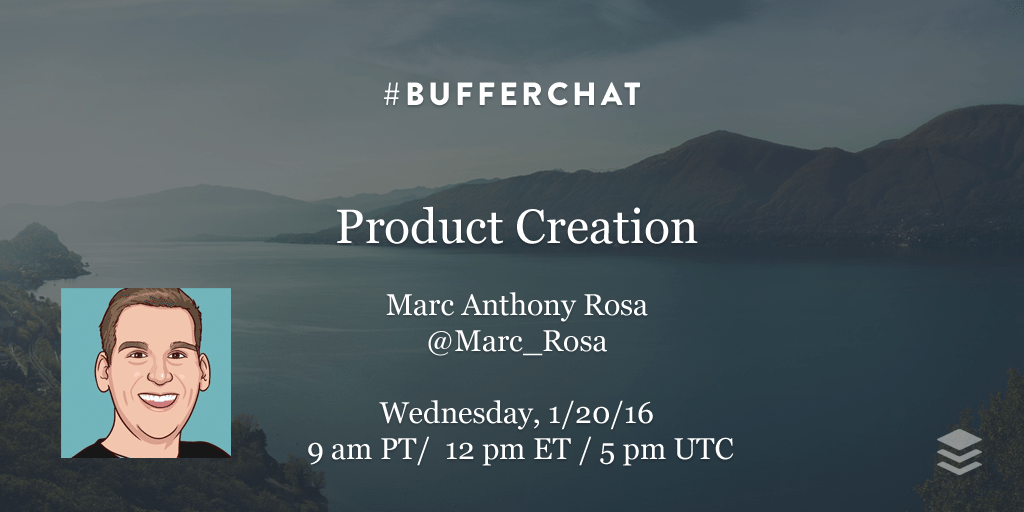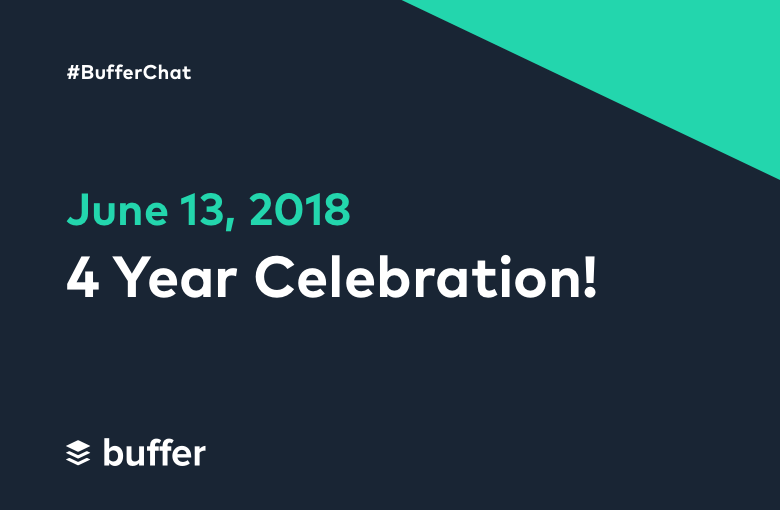
In the #bufferchat this week, Buffer’s very own product creator Marc Anthony Rosa joined us to chat about the process of product creation! We discussed the aspects of a great product, shared ways to collaborate while creating a new product, and explored how products can solve user needs.
Catch our weekly Twitter chat, #bufferchat, every week on Wednesdays, 9 am PT / 12 pm ET / 5 pm UTC, for valuable industry insights and networking with nearly 400 other smart marketers and community managers. It’s a fun time!

Q1: What is the mark of a truly great product?
From Marc Anthony:
- To me, a truly great product is one that solves a painful problem for a targeted group of users really, really well.
- Simplicity is usually associated w/ great products, perhaps the byproduct of hyper-focusing on Problem/Solution Fit!
- Since a great product masters few problems well, the resulting experience feels “obvious” & usually lacks complexity.
From the community:
- “The best products also grow up with their customers. As the product improves, so do the lives of their users.” @TheCoolestCool
- “One that blends into your life seamlessly and quickly becomes indispensable.” @AlexisTheory
- “In addition to solving a specific problem, it should be very user-friendly, created w/ empathy for the end user.” @emilyenroute
See all the great answers to question 1 here!
Q2: Where might product ideas come from?
From Marc Anthony:
- Product ideas come directly from the source: from our users, as painful problem hypotheses worth solving!
- Virtually all of our product ideas come from user feedback, whether originating as a upvoted request on UserVoice…
- …or from common problem themes surfaced during Customer Development calls! ?
- For example, our users shared with us that posts were more successful when they contained images.
- At the same time, we’ve commonly heard how challenging it might be to create engaging social images.
- This led us to ask ourselves “how do we empower our users to create engaging social images in under 30 seconds?”
- Throughout this journey, we found ourselves validating what ultimately became Pablo ?
From the community:
- “Start with one idea. Bounce more ideas off others. More with your community. Hone in on the best outcome. Rinse and repeat.” @lafitara
- “That moment you think “I wish there was an easier way to do this.” @alanakwhite
- “Deep dive into Reddit around your industry. AMAZING stuff awaits there.” @tedbauer2003
See all the great answers to question 2 here!
Q3: What are great ways to share ideas and collaborate while creating a new product?
From Marc Anthony:
- We love using Dropbox Paper for collaborating around data, product hypotheses, CustDev feedback, designs…
- … spec creation, and virtually all aspects of the product creation cycle!
- We use Trello to follow the entire process, and we’ll lean on Slack and Zoom for communicating synchronously.
- Our product creation process involves multiple people, multiple ideas, multiple explorations – transparency is key.
From the community:
- “Let everyone know that there’s no such thing as a silly question! The more you ask, the more you discover.” @lifeofaworkgirl
- “Whiteboard the heck out of it. Whether on a physical board or a
@trello dashboard, get your ideas out there.” @lilfrankie_13 - “
#Socialmedia again is a great sounding board. Twitter Chats/LinkedIn Groups/Facebook communities…make it fun and engaging!” @joegill88
See all the great answers to question 3 here!
Q4: Have you ever used a product differently than it was intended? How can that influence product creation?
From Marc Anthony:
- Great one, this happens all the time! Reflecting on our products, Buffer Calendar is an example of this happening.
- The Calendar began as a way for users to plan their upcoming weeks & months (I hope it solves this for you nicely!).
- To our surprise, we’ve found that the Calendar is a huge driver of Re-Buffering content…
- …where the Calendar is powerful for going back in time, as a way to reference dates when retrieving top content ?
- These learnings inspire adjustments to our path, and help us create a much richer, more valuable product experience.
From the community:
- “All the time! It makes you realize that you can’t assume how someone is going to use your product; you need to use it too!” @danielleirogers
- “I reckon it’s the best way to get closer to Product Market Fit, finding people who think differently.” @sarahnbeeson
- “I used to only push the headphone jack into my stereo halfway so that I could hear the vocal harmonies of a song.” @ShannonLGilstad
- “Of course! Playing around with alternate uses for things is what gives us ideas for entirely new products!” @MarkOnBrands
See all the great answers to question 4 here!
Q5: What is a big challenge when it comes to product development?
From Marc Anthony:
- One challenge is always around being Lean. How can we test the riskiest product assumptions w/ the fewest resources?
- What are ways we can validate the solution before we actually build it?
- Another big challenge is to remember that every problem has a number of potential solutions.
- If one solution doesn’t quite work for our users, that usually doesn’t invalidate the problem to be solved.
From the community:
- “You can’t please everyone; don’t always have to achieve perfection to make a difference but can be challenging to let go.” @_KirstenT
- “Getting past the fear of failure. It’s so important to remember that failure is productive for your product!” @sola_eclipses
- “Keeping your users interested & engaged. Consumers are constantly evolving their wants & needs.” @BaylaKressi
See all the great answers to question 5 here!
Q6: When do you know a product is ready to ship/go public?
From Marc Anthony:
- We use a few metrics! Ex: we might set lines in the sand, “we deploy if Daily Active Users increases by >10%.”.
- We might use Product/Market Fit surveys, where we ask users how they feel if they weren’t able to use this feature.
- We typically look for >40% of users responding “very disappointed”.
- Methods depends on how we define success for that product, where we seek ways to quantify the degree of that success.
From the community:
- “When it no longer breaks in testing, push it live so someone else can figure out how to break it.” @BendandBrew
- “Tough Q! “If you are not embarrassed by the first version of your product, you’ve launched too late.” Reid Hoffman.” @CMGRMelissa
- “The sooner you get the product out there, the sooner you’ll be able to see what works & what doesn’t!” @BrightHausGroup
See all the great answers to question 6 here!
Q7: How might you spend your time if you’ve got one hour to solve a user problem or need?
From Marc Anthony:
- I would spend the entire hour on Customer Development, focusing on the problem hypotheses – absent of any solutions!
- “What problems are we solving? Who has this pain? How do users solve these problems today?”
From the community:
- “Take a step back, relax, breathe, and then assess the user’s situation. Important to listen to what the user has to say.” @Yung_adQ
- “Work with your customer/client e.g. observe their experience, listen to their feedback, put yourself in their shoes.” @_KirstenT
- “Start by replicating the user journey that resulted in the identification of the problem.” @akwyz
See all the great answers to question 7 here!
—
Thank you so much to Marc Anthony and to everyone who participated in this awesome chat!
Catch #bufferchat each Wednesday at 9 am PST, 12 pm EST, 5 pm UTC. Join our new Slack community with over 1,000 members to continue these awesome conversations all week long!
Do you have any comments or answers to these questions? Leave your thoughts in the comments! We’d love to hear from you!
Image sources: UnSplash
Try Buffer for free
140,000+ small businesses like yours use Buffer to build their brand on social media every month
Get started nowRelated Articles

We’ve decided to retire #bufferchat after four years and had a celebration with our community, Read on to discover all of the memories and fun shared during the chat! This week’s stats: Bufferchat (9 am PT): 118 participants; reach of 1,655,682 Q1: What’s been your favorite #bufferchat topic? From the community: A1: There’s been so many great #bufferchat that resonated with me. Standouts include: ✅Email Marketing with @p

This week on #bufferchat our community shared all the best tips and tricks to avoid social media burnout. Read on to discover all of the awesome insights shared during the chat! Catch our weekly Twitter chat , #bufferchat, at TWO times every Wednesday for valuable industry insights and to meet hundreds of other smart marketers and social media enthusiasts. Same topic, same place, just at different times – feel free t

This week on #bufferchat our community discussed the ins and outs of marketing on Pinterest. Read on to discover all of the awesome insights shared during the chat! Catch our weekly Twitter chat , #bufferchat, at TWO times every Wednesday for valuable industry insights and to meet hundreds of other smart marketers and social media enthusiasts. Same topic, same place, just at different times – feel free to join